CISL staff honored for extraordinary contribution in 2017
Thirty-one CISL staff were selected to receive 2017 Special Recognition Awards. Given annually as part of the UCAR Employee Recognition process, these awards acknowledge extraordinary work performed such as:
- Services of outstanding quality or of unusual importance to the execution of UCAR’s programs
- Commitment to activities or demonstrated outstanding skill or effort above and beyond prescribed duties and workload
- Significant savings of time or money
- Excellent level of performance during an organizational emergency or period of high stress
- Great ingenuity or perseverance
These awards are not for sustained excellence in assigned duties or sustained performance of duties not included in the employee’s job description, as such efforts are recognized in other ways.
The awards were presented by the people who nominated staff for recognition.
Providing interim executive support of the CISL Front Office during transition
Joan Fisher was recognized for taking the lead to ensure that CISL’s Front Office continued to function at a high level during an unexpected absence of administrative support. Joan also led all administrative aspects of the International Computing in Atmospheric Sciences (iCAS) 2017 workshop in Annecy, France. Further, she provided leadership and support during the transition to UCAR’s new UProcure System for purchasing. She did this while maintaining an excellent level of performance in her existing duites. She was extremely organized, diligent, and resourceful throughout this time.
Volunteering as the Concur coach for CISL
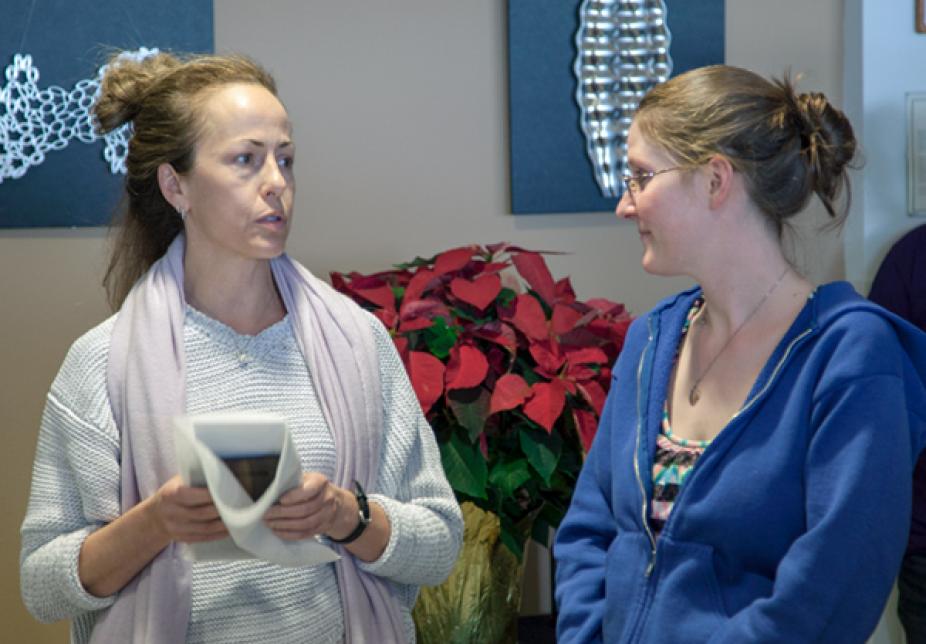
Michelle Patton (right) received her award from Elizabeth Chapin.
Michelle Patton served as CISL’s primary point of contact for staff and administrative support for Concur, UCAR’s new expense management system. She took the lead on reporting issues to the Concur team, researching and responding to user questions, and reporting to the CISL administrative team. She clearly communicated upcoming trainings and information for CISL staff and met one-on-one to set up travel profiles and t-cards. Michelle’s excellent work went way above and beyond her normal job duties. As a new NCAR employee, she performed at a high level that was widely recognized. Having Michelle as a Concur coach greatly helped CISL staff begin using this new system, and for many staff she made the transition almost seamless.
Providing interim support of the SIParCS program
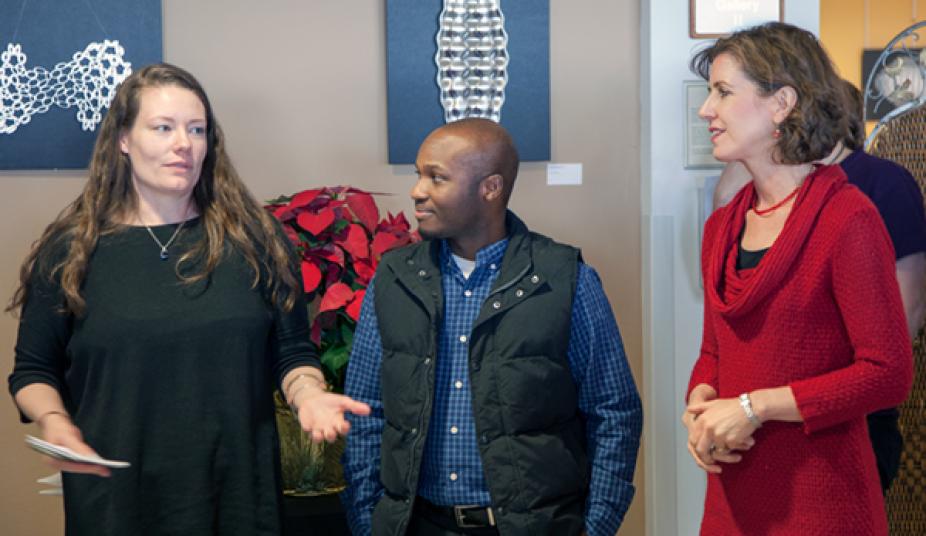
Mary Pronk (right) and Eliott Foust received their awards from AJ Lauer.
Eliott Foust and Mary Pronk stepped in to manage all parts of the 2017 hiring and springtime preparation for CISL’s SIParCS internship program. Managing SIParCS logistics is a large and complex task that requires constant attention, particularly throughout the spring months while preparing for the interns’ arrival. This year’s program attracted 167 applicants competing for only 14 positions, which increased the management challenge. Eliott managed student communications and preparation for their needs outside the Mesa Lab. He updated the SIParCS website and planned the two orientation days. He also traveled to represent SIParCS and NCAR at four external events. Mary managed all human resources responsibilities for the 14 interns, oversaw their hiring process, and coordinated all interactions between CISL and UCAR Human Resources. Mary also supported mentors and interns via phone and email.
Supporting the NWSC Open House event
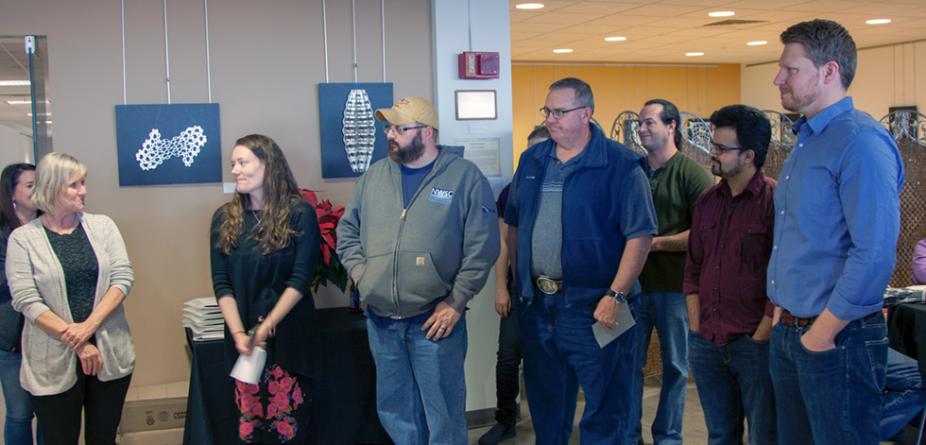
From right, Matt Rehme, Raghu Raj Prasanna Kumar, Gary New, Michael Kercher, and at left, Eileen Carpenter received awards from AJ Lauer (second from left). Not shown: Mary Waterstreet, Courtney Gibson, Jim Van Dyke, Tim Barnes, Olga Tweedy, Aaron Andersen, and Tim Scheitlin.
Mary Waterstreet, Courtney Gibson (UCAR HR), Raghu Raj Prasanna Kumar, Michael Kercher, Jim Van Dyke, Tim Barnes (UCAR SciEd), Olga Tweedy, Aaron Andersen, Gary New, Matt Rehme, Tim Scheitlin, and Eileen Carpenter (UCAR SciEd) collaborated to produce a successful Open House event for the NCAR-Wyoming Supercomputing Center (NWSC) during the 150th anniversary of Cheyenne, Wyoming. This team presented visualizations, the Meteo-AR app, interactive science activities, tours of the NWSC, and Raspberry Pi robot races for over 240 guests from Cheyenne and across Wyoming. Notable contributions came from Mary Waterstreet, who readied the facility for the expected guests, scheduled Gary New’s appearance on Cheyenne’s Channel 5 News, and increased the security team for the event. Tim Barnes’ role in advance of the event was critical to the visitors’ experience. He worked with AJ Lauer and Marijke Unger to develop a new interactive activity that helps visitors understand the benefits and efficiencies of parallel processing. This activity is a portable and effective learning tool that will be used at future events. Everyone on this team did outstanding work and went above and beyond their normal job duties. The outstanding quality of their efforts presented CISL and UCAR in a most positive light to the Cheyenne community.
Organizing a distributed project to refactor the Model for Prediction Across Scales

Raghu Raj Prasanna Kumar (right) received his award from Rich Loft.
Raghu Raj Prasanna Kumar tackled three externally funded code-porting projects during the past year. The first was funded by NVIDIA, the second by Intel, and the third by IBM and The Weather Company (TWC). All three efforts focused on the Model for Prediction Across Scales (MPAS), a collaboration to develop atmosphere, ocean, and other Earth System simulation components for use in climate, regional climate, and weather studies. Raj’s outstanding work included external relationship development and management with the vendor partners, support and training of his distributed team of graduate students, persistence and debugging prowess in overcoming complex technical obstacles related to deploying and verifying MPAS on multiple vendor and in-house systems, and innovation in performing code refactoring and optimization. He led many of the technical debugging efforts with the vendor experts, matching their expertise and occasionally supporting them (as opposed to vice versa). His efforts created new funding opportunities and have changed the landscape of what is now considered possible in the future development of NCAR codes on advanced computer architectures.
Innovative and sustained work on lossy compression
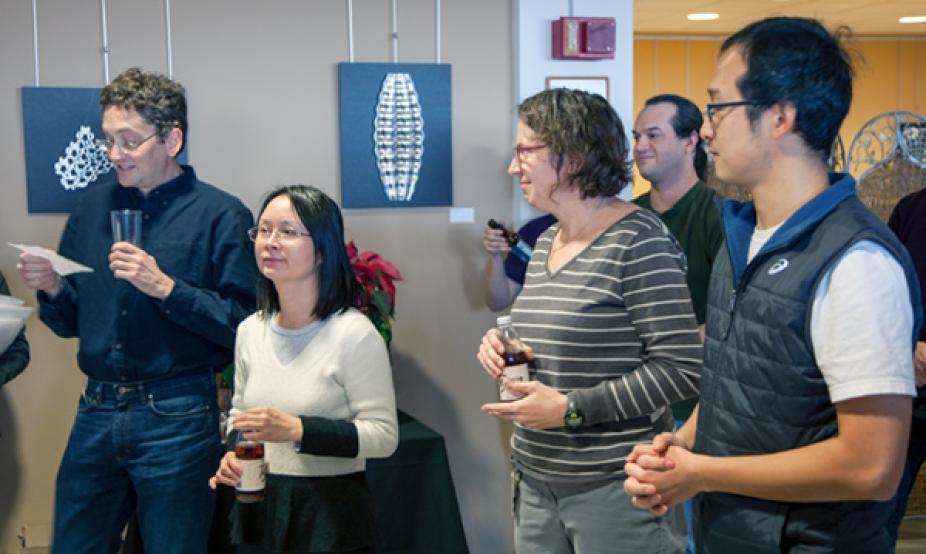
Samuel Li (right), Allison Baker (center), and Haiying Xu receive their awards from John Dennis.
Allison Baker, Haiying Xu, and Samuel Li helped develop a data compression technology that addresses a growing and critical shortage of storage and its high associated costs at NCAR. Lossy compression holds enormous potential to maintain the scientific value of massive data without requiring researchers to store all of it. Lossy compression is a truly challenging subject to get right: it involves a multitude of dimensions ranging from interface and integration questions, algorithms, and complex quality control aspects to psychological aspects such as trust-building and acceptance by the user community. These three people collaborated with people from other groups and outside the organization, and they helped bring NCAR to the forefront of research and implementation of lossy compression for climate data. This team produced an impressive six publications on this topic in the last three years. Their work covers algorithm developments, user evaluation studies, multi-method comparison studies, exploring the benefits of combined temporal and spatial domain compression, in situ compression, quality control related to compression, and computational integration and feasibility, among other topics. Finally, in addition to their own work, they have provided exceptional support for research in which they were not directly involved, but where their data and expertise was crucial.
Contributing to NCAR’s NSF LCCF proposal
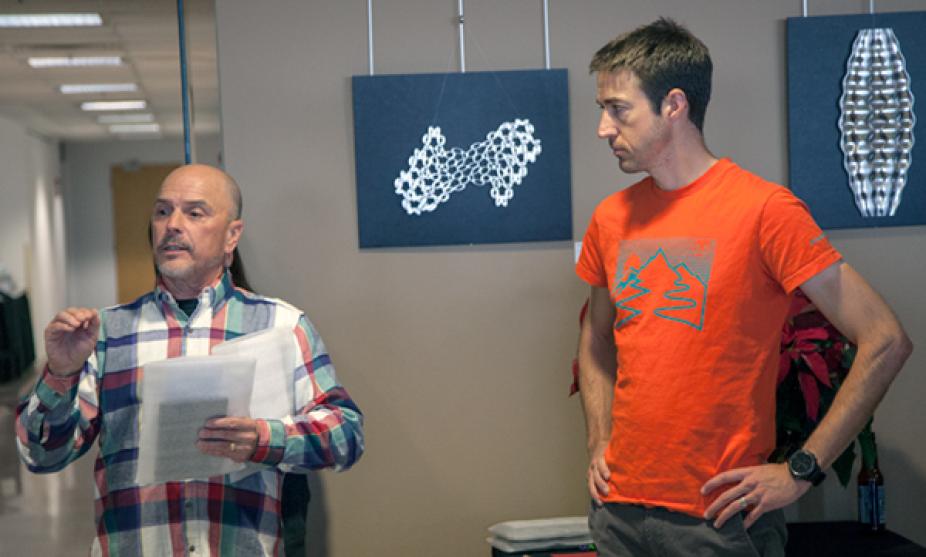
Rory Kelly (right) received his award from Mick Coady.
Rory Kelly was recognized for his extraordinary effort and contribution to NCAR’s joint proposal to the National Science Foundation for a Leadership-Class Computing Facility (LCCF). NCAR’s partner in the proposal, the University of California at San Diego, specifically requested that Rory lead the system benchmarking efforts for the partnership. He scheduled and coordinated complex benchmark runs between the two institutions, and he organized numerous weekends where NCAR’s Cheyenne supercomputer was dedicated to running the benchmarks. These often required Rory to work 16 hours or more per day to complete the many required iterations of configuring, optimizing, and running the benchmark suites. Running on weekends was required to minimize the impact on NCAR’s HPC users, and Rory accomplished all of it with professionalism. He also built a compelling case for the UCSD/NCAR proposal while dealing with issues in a supercomputing environment that was still relatively young and unsettled. He did all of this in addition to fulfilling his regular duties as a CISL HPC Consultant. The potential financial impact of this proposal to NCAR is significant. If it is funded, it would bring enormous prestige to NCAR and CISL, and Rory’s contributions will have played a major role.
Contributing to the ECCS program for NSF’s XSEDE meeting
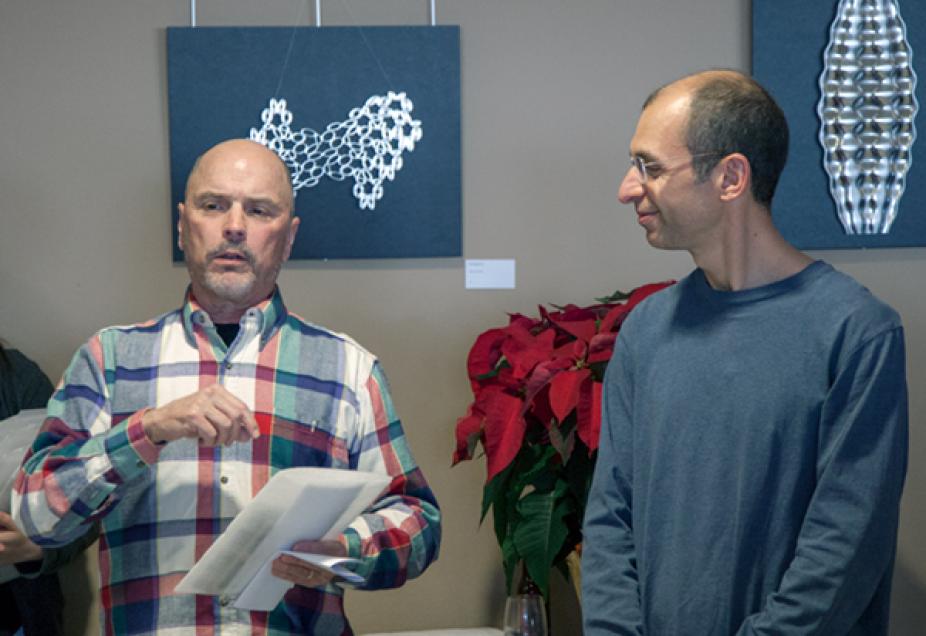
Davide Del Vento (right) received his award from Mick Coady.
Davide Del Vento was singled out at the 2017 XSEDE all-hands meeting as the ECSS “Rookie of the Year” for the timeliness and quality of his work and his eagerness to help solve problems. His exceptional contributions to the Extended Collaborative Support Services (ECSS) program for the National Science Foundation’s Extreme Science and Engineering Discovery Environment (XSEDE) meeting were above and beyond the organizers’ expectations. He stepped in to support two new ECSS projects, “Novel and Innovative Projects” (NIP) and “Extended Support for Training, Education, and Outreach” (ESTEO). His contributions to the NIP project enabled vegetation modelers with no prior HPC experience to submit jobs from an environment hosted on Indiana University’s Jetstream cloud computing infrastructure and execute them on the Pittsburgh Supercomputing Center’s cluster, Bridges. The expertise that he gained from his contributions not only directly helped the NIP project, but it also promises to guide and impact NCAR’s future cloud computing efforts. For the ESTEO program Davide organized the U.S. participation in the International HPC Summer School that was held in Boulder on the University of Colorado campus. The school’s goal is to prepare current and future generations of HPC academics and professionals. Davide took responsibility for managing much of the local logistics and general coordination of the U.S. participation. The event was hailed as a major success and helped highlight NCAR’s prominence in many HPC fields including data-intensive computing, scientific visualization, algorithm development, and performance analysis.
Developing new network firewalls

From right, Simon Webster, Matt Adler, Scot Colburn, Susan Ramsey; from left, Paul Dial and Nick Wehrheim received their awards from Marla Meehl (center).
This award for Susan Ramsey, Simon Webster, Nick Wehrheim, Matt Adler, Scot Colburn, and Paul Dial recognizes their creativity and teamwork in deploying new network security hardware in an innovative and effective system solution at NCAR. They successfully integrated two new network routing devices that protect UCAR’s enterprise and guest networks and provided failover redundancy; support Internet Protocol version 6 (IPv6), Multicast, and all UCAR campuses including NWSC, RAF, and MFS; and maintain existing router access control lists (ACLs) while allowing ACLs to be shifted to one of the new devices if a transmission error occurs. Their work produced an elegant and supportable solution that simplified the user experience of guests, improved network security, reduced costs, and improved efficiencies. This project was an example of excellent teamwork requiring communication, coordination, and collaboration.
Developing and implementing the NWSC MULE and Ginny network projects
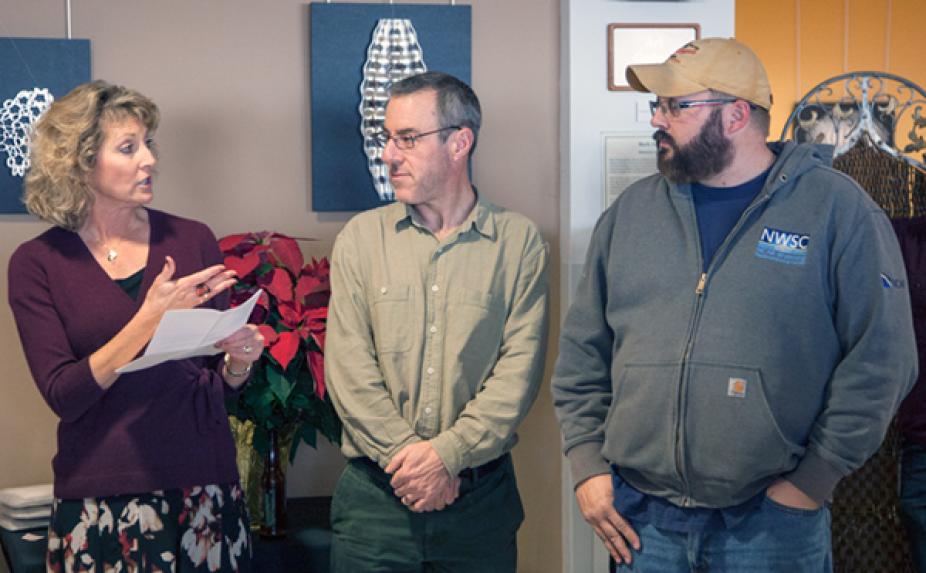
Michael Kercher (right) and Scot Colburn received their award from Marla Meehl. Not shown: Pam Hill and Jim Van Dyke.
The Multi-User LAN Ethernet (MULE) and Ginny systems (see diagrams below) connect the existing centralized high-performance file system (GLADE-1) with the new one (GLADE-2), while also integrating legacy supercomputer resources into the upgraded storage network. The team members coupled commitment, outstanding skill, and long-term efforts with great ingenuity and perseverance to resolve the design and implementation challenges. Their novel approach created NETS’ first storage area network (SAN). They resolved technical difficulties arising from first-time use of new hardware as an integrated SAN and Wide Area Network (WAN) switch/router, first-time speeds of 40 Gbps in the SAN and data center, first-time WAN speeds of 100 Gbps, all in time to get the Cheyenne supercomputing system into production on schedule. This required working with and between vendors and building relationships with and between vendors that were not in place. And their work saved significant time, space, and money.
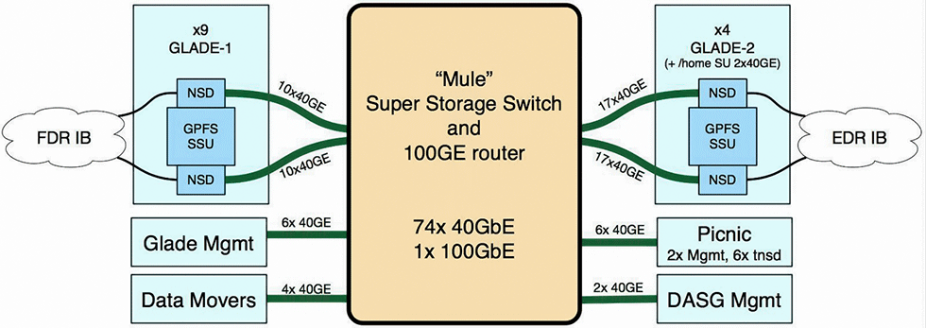
The MULE switch provided the high-speed inter-GLADE connectivity when GLADE was connected on both EDR and FDR, and it continues to provide direct access to the 100-Gbps Wide Area Network path and all Ethernet hosts connected to Ginny and the rest of UCAR.
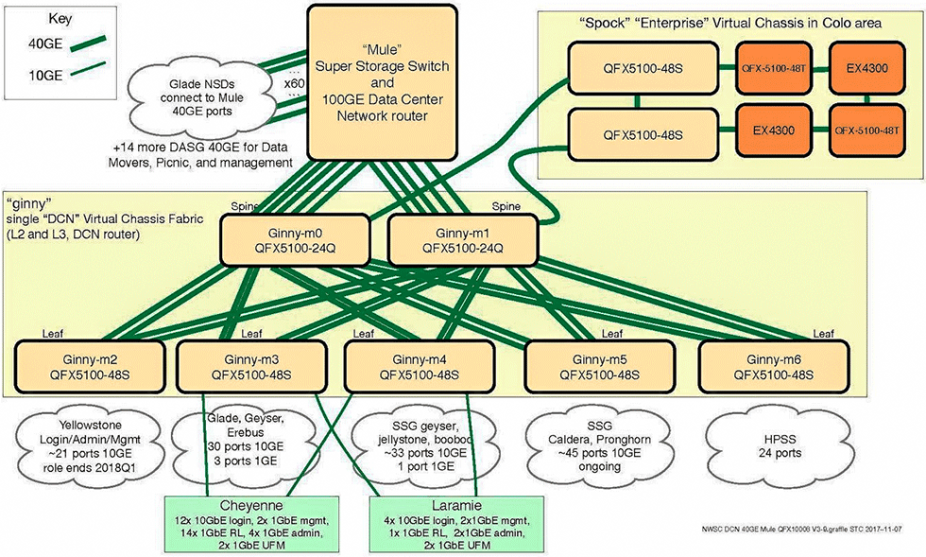
The Ginny network fabric provides the data center connectivity between GLADE/MULE, enterprise services, legacy visualization clusters, supercomputers, and HPSS resources.